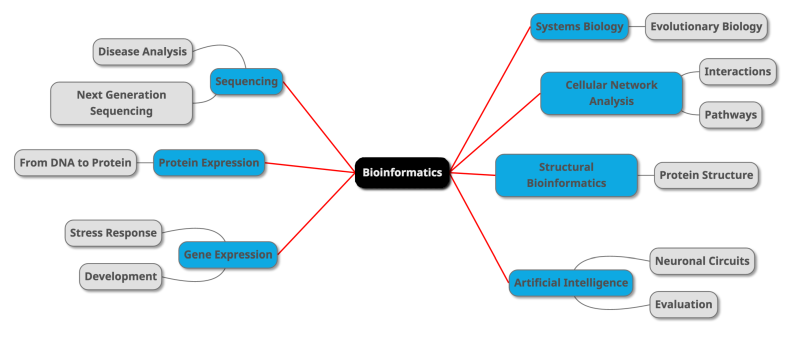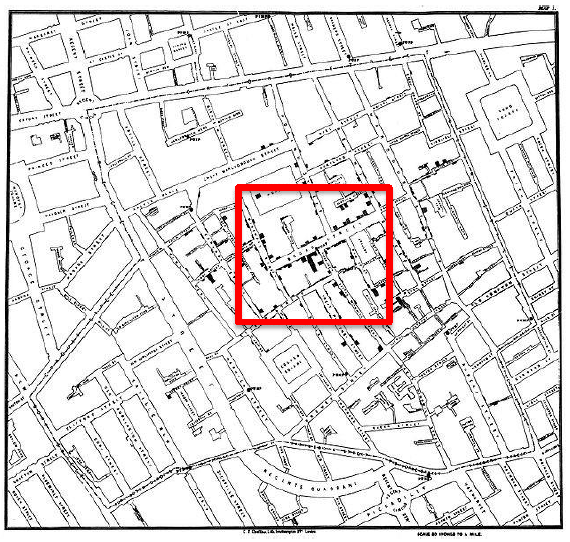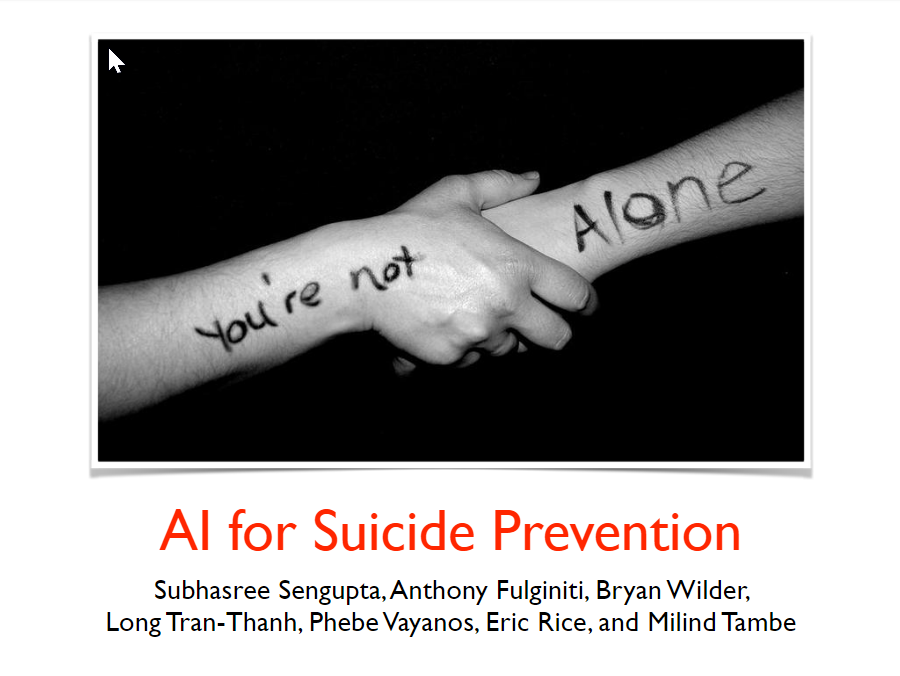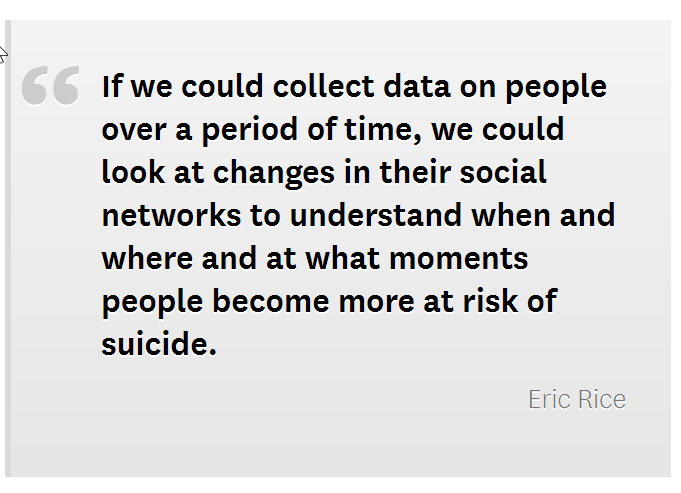1/25
***
←
→
Health, medical
societal
applications
|
Body, mind [and brain, heart, soul, intellect... :)]
We're evolved, biological beings - with bodies, who live in societies...
Fitness, health, nutrition, disease/injury/damage to the body and mind - these are worldwide concerns.
So, data [science] can play a HUGE role in how we deal with the above!
In EVERY slide that follows, look for the 'data' angle [it's in there!]: collection, processing (analytics, ML...), action (utilization of results), privacy/security/goverance...
Topics that follow are somewhat sequenced.
Bioinformatics
This is the science of analyzing genome data, to put it simply - involves DM/ML, for things like disease prediction.
This is a graphic from University of Mainz, that shows the various specialties within bioinformatics:

This is a typical bioinformatics grad-level course - note that knowledge of the DOMAIN [biology] is 100% a pre-requisite!
The Human Genome Project was one of the earliest 'data science' triumphs for humankind... It involved decoding 3 billion 'base pairs' in ~40,000 genes [each of which has a function/purpose!], in 23 chromosomes.
Today, gene sequencing is an established science, using which we can map out our ancestry, predict [and prevent, or treat] disease... Here is a paper (from 2012) that explains the steps involved.
Electronic Health Records (EHR), privacy
A hospital visit, and stay, generates a MASSIVE amount of data - medical tests, diagnosis, physician and hospital costs, billing info... Not long ago, none of this was searchable/shareable in a 'big' way [each hospital and insurance company had its own system for storing and processing these, eg. here is a 'coding' (with primary-key codes that stand for procedures) page used in the dental insurance industry].
Today, EHR is becoming standardized. And along with that come data solutions from providers big and small, to help hospitals and physician groups COLLECT, STORE and MANAGE all this data.
Who owns a patient's data that a hospital stores? Answer - not the patient, yet!
In the US, HIPAA protects patients' medical privacy - heathcare data needs to be kept secure, to comply with HIPAA.
Fitness can be data-fied; nutrition too
Your fitness tracker device measures a variety of data while you work out - here are some ways to benefit from the data.
Here are the results of mining heart-rate data, from a wide range of people.
Food is FULL of data - calories, sugar, fat, carbs, salt, allergens, that affect our weight, blood sugar, BMI, heart rate, sleep patterns...
'Feeding' (!) this trend are a variety of apps that help: food => data => analyze => benefit [eat well, stay fit, lose weight etc.]
Here is an article on a USC effort - use data ('AI') to help form peer groups of people where healthy individuals can INFLUENCE (eating) behavior.
Heart disease; cancer
One way to monitor the heart on a regular basis, is to use smartphone camera to capture a 'pulse wave' and use it to measure 'arterial stiffness' (which in turn is a measure of heart health).
This monster of a disease has no universal cure - but research is chipping away at early diagnosis (and cure), treatments, management. Data analytics is another tool, in cancer research. USC's own Institute for Transformative Medicine does exactly this!
Also, it might be possible to tailor cancer treatment for an individual, based on THEIR (tumor) data, by comparing (correlating) it with known data from a cancer database - this is the idea behind this group's research here at USC.
Infectious diseases - spreading
If real-world data is used to create a spreading model, the model could alert us to outbreaks - here is USC's work on this.
Even "simply" visualizing the spread of infectious diseases is useful - humans can notice patterns in the animations, and act. Here are links to visualizing Zika virus spread [Ebola spread can be visualized similarly].
GLEAM is a tool for disease-related spatial data viz.
Here is a spread map, from 1854 [this is the whole story]!

To practice, you can even create your own disease maps.
Images => diagnosis
Diagnostic x-rays [body (heart, lung, limbs...), teeth, face...], MRI/CAT/PET scans, retinal scans, smartphone pics of a wound, cut, insect bite, rash... all these are/can be used for diagnosis. Such data can be annotated (labeled, by human experts), and be 'learned' via ML - result - "automated diagnosis".
While these won't (shouldn't, CAN'T!) replace human doctors, they CAN serve as a first-level diagnosis, tele-medicine proxies, etc.
Mental disorder: autism
Kids [and adults] on the 'spectrum' can immensely benefit from patient, personalized care in the form of socially assistive robots.
Here is another fascinating approach (a form of AR).
USC's own Maja Mataric is a pioneer in this field of 'SAR'.
Mental condition: PTSD
Soldiers, athletes etc can sustain serious TBI and PTSD, which puts them at ongoing risk while living in society. VR Exposure Therapy (http://ict.usc.edu/prototypes/pts/) or a Virtual Therapist (https://futurism.com/uscs-new-ai-ellie-has-more-success-than-actual-therapists). USC's ICT does such innovative work, and MUCH more: http://ict.usc.edu/prototypes/all/.
Mental health: suicide prevention
'Gatekeeper Training' at U of Denver is a project that uses AI to strategically decide whom to train, to intervene when suicide signs are detected - the idea is to leverage social connections data, to construct a network of friends and groups that students belong to, and use that to select individuals who will have maximal impact on helping suicidal students.


This USC project uses ML to detect changes in a veteran's social network, and use that to ascertain suicidal behavior, anxiety, depression.
Mental health: drug addiction
"Thanks to" evil companies such as Purdue Pharma, and overseas "manufacturers", parts of the US have been ravaged by opioid abuse.
A USC project employs deep learning to identify candidates for addiction [using prescription and medical history of >100K patients], and group addicts during recovery.
Geriatrics: detecting falling
For older adults, falling presents serious risk - and falling can be monitored by a simple wrist-worn sensor [or stationary cameras].
Brain mapping!
GRAND aim - "map" the human brain: http://www.ini.usc.edu/
Neuroinformatics concerns itself with modeling and analysis of brain-related functions.
Just like a genome is a big-picture diagram of gene sequences, a connectome is a wiring diagram of the brain's neural connections - here is more.
Drugs (the legal kind!)
The drug industry is a worldwide, multi-billion-dollar one. Supposedly a large part of their R&D budget goes into creating new drugs. 'Rational drug design' (RDD) is a data-driven, systematic approach to creating new (classes of) drugs, as opposed to a blind, or ad-hoc, or creativity-driven, or intuition-driven one.
Here is an article that presents an approach to RDD.
Biometrics as ID
A useful application of ML is to authenticate an individual based on a variety of natural 'markers' such as face, fingerprints, iris patterns, voice, etc.
An interesting use of this a self-service police station...
Surveillance - good, bad..
Data that is captured about you, can be used to TRACK you, Big Brother-style!
Two interesting examples - facial recognition in Chinese classrooms [eg. to assess emotion!], gait recognition.
Also, license plate info is not illegal to collect, in most US states!
ML can provide automated surveillance of property.
LAPD uses data-driven policing practices in some neighborhoods, to tactically deploy their assets.
Interviewing young crime victims
A USC project underway: 'Forensic interviews with children require optimal interviewing strategies to elicit accurate information and minimize the emotional impact of recalling traumatic events. Researchers are exploring the role of speech and language processing and using such tools as computational metrics to identify the most effective words and techniques to use with young victims and witnesses of crimes.'
Homeless youth: HIV prevention, housing assistance
This USC project aims to help at-risk homeless youth to seek help/testing. There is more info here.
A[nother] USC project: greedyMMD is an algorithm that optimally assigns housing to high-risk homeless youth.
Strategic incident response
This DSSG project helps optimize allocation of static, and mobile, [traffic indicents] response personnel, with the aim of restoring normalcy at the earliest.
Dealing with unemployment
This DSSG project aims to identify patterns of unemployment, to help unemployed people quickly get back to being employed.
Public assistance
This DSSG project identifies patterns in peoples' use of multiple assistance services, to pick out the neediest and help them the most.
'Love'ly data science!
eHarmony worked with a USC researcher to help create accurate personality profiles and matches.
Also, Hannah Fry's 'The mathematics of love' is a look at PATTERNS of human behavior, related to love and sex.



